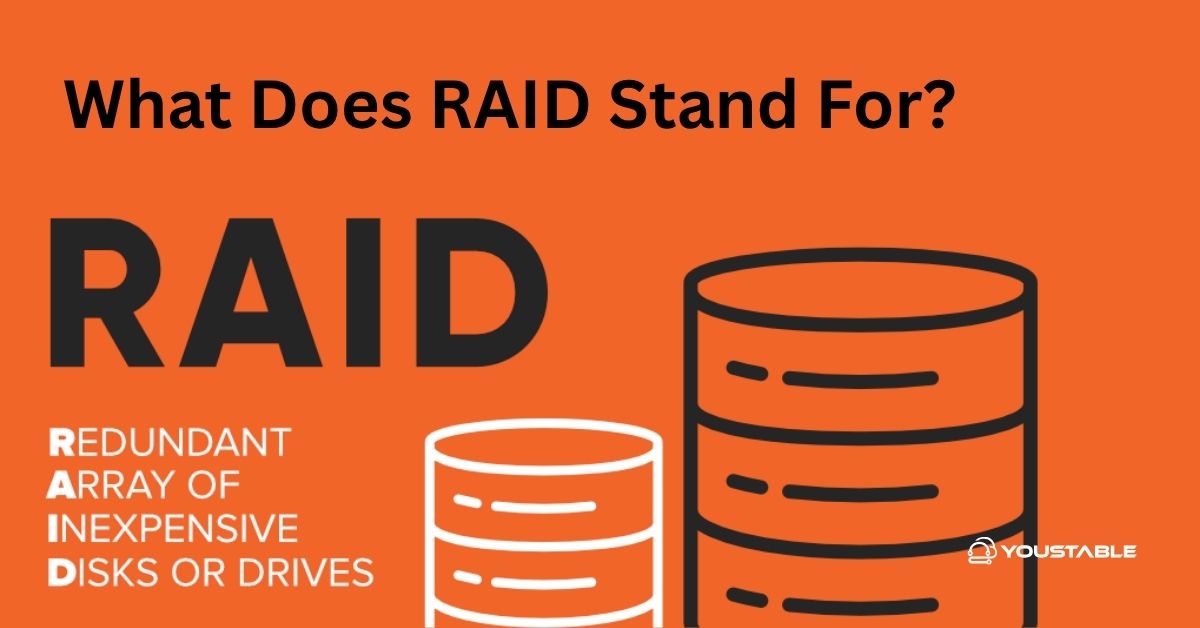In the world of data storage, redundancy and performance are essential aspects to consider. One way to enhance these aspects is through a technology known as RAID, which stands for Redundant Array of Independent Disks. RAID allows you to combine multiple physical hard drives into a single logical unit, providing benefits like improved performance, data redundancy, and fault tolerance.
This article explores RAID and focuses on the different RAID levels, including RAID 0, RAID 1, RAID 5, and RAID 10.
What Does RAID Stand For?

RAID stands for Redundant Array of Independent Disks. It is a technology that combines multiple hard drives into a single array to improve performance, provide fault tolerance, or balance both. The concept behind RAID is to distribute data across several drives in ways that enhance the speed of data retrieval or protect against data loss in the event of a drive failure.
RAID can be implemented in different configurations, known as RAID levels. Each RAID level has specific characteristics that offer different advantages in terms of performance, storage capacity, and data redundancy.
Why Use RAID?
RAID systems are commonly used to increase the reliability and speed of data storage. Here are a few reasons why you might consider using RAID:
- Improved Data Protection: RAID systems often mirror data or store it in redundant formats, ensuring that even if one drive fails, your data remains safe.
- Enhanced Performance: By striping data across multiple disks (RAID 0 or RAID 10), the system can read and write faster, improving overall performance for tasks like video editing or database management.
- Redundancy and Fault Tolerance: Some RAID levels, like RAID 1 or RAID 5, ensure that data is copied or protected in case of hardware failure, preventing data loss.
Check Out | Network File System: What is nfs in Linux?
Types of RAID
RAID (Redundant Array of Independent Disks) is a data storage technique that combines multiple hard drives into a single system to improve performance, reliability, or both. Different RAID levels offer varying speed, fault tolerance, and storage efficiency balances. Choosing the right type depends on your needs—faster access, data protection, or maximum usable space.
RAID 0: Striped Array (Performance Focused)
RAID 0 is one of the simplest RAID configurations. It strips data across multiple disks, increasing the performance by allowing multiple disks to read and write simultaneously.
In a RAID 0 setup, data is split into blocks and written across two or more drives. For example, in a two-disk array, the first part of a file is written to the first disk, and the second part is written to the second disk.
RAID 0 Pros and Cons
Here’s the updated table with no bullets or numbers, and no bold text:
| Pros | Cons |
|---|---|
| Increased speed: Boosts read and write operations. | No redundancy: Data is lost if one drive fails. |
| Maximum storage utilization: Full capacity of all drives. | Risk of data loss: No backup or protection. |
| Improved performance: Multiple disks working together. | |
| Cost-effective: No need for extra drives for redundancy. |
RAID 1: Mirrored Array (Redundancy Focused)
RAID 1 mirrors data across two or more disks, ensuring redundancy by storing an exact copy of the data on each drive.
When you write data to a RAID 1 array, the data is duplicated on each drive. This means that if one disk fails, the data can still be retrieved from the other disk.
RAID 1 Pros and Cons
| Pros | Cons |
|---|---|
| Provides full data redundancy | Usable storage is only half the total capacity |
| Ensures high availability during failure | No significant performance boost for write operations |
| Simple to set up and manage | |
| Improves read performance slightly |
RAID 5: Striped with Parity (Balanced Performance & Redundancy)
RAID 5 offers a balanced approach between performance, data redundancy, and storage efficiency. It uses both striping and parity to ensure data protection.
In a RAID 5 setup, data is striped across three or more disks, and parity information is distributed across all disks. Parity allows the system to reconstruct data in case of a single disk failure.
RAID 5 Pros and Cons
| Pros | Cons |
|---|---|
| Improved read performance due to striping | Slower write speeds because of parity calculations |
| Can tolerate one disk failure without data loss | Risk of data loss if another disk fails during rebuild |
| Offers a balance of performance and redundancy | |
| More efficient use of disk space than mirroring |
RAID 10: Combination of RAID 1 and RAID 0 (Performance + Redundancy)
RAID 10, also known as RAID 1+0, combines the features of RAID 1 and RAID 0, offering both performance and redundancy.
RAID 10 combines two RAID 1 arrays and then strips them in a RAID 0 configuration. This means you get data mirroring (RAID 1) and striping (RAID 0) in a single system.
RAID 10 Pros and Cons
| Pros | Cons |
|---|---|
| Delivers excellent read and write performance | Usable storage is only 50% due to mirroring |
| Provides strong data redundancy | Requires at least four disks, increasing cost |
| Offers high fault tolerance within mirrored sets | |
| Ideal for high-performance, critical applications |
Comparing RAID 0, 1, 5, and 10
To help you decide which RAID level is best for your needs, here’s a quick comparison:
| RAID Level | Speed | Redundancy | Storage Efficiency | Best For |
|---|---|---|---|---|
| RAID 0 | High | None | 100% | Performance-critical tasks |
| RAID 1 | Moderate | High | 50% | Critical data storage |
| RAID 5 | High | Moderate | Efficient | Balanced usage (servers, SMBs) |
| RAID 10 | Very High | High | 50% | High-performance, fault-tolerant systems |
RAID Configuration and Setup (Simplified)
There are two main ways to set up RAID: hardware and software.
- Hardware RAID uses a physical RAID controller (built into the motherboard or as a separate card). It handles all the RAID tasks, so your system runs faster. This is great for performance but costs more.
- Software RAID is managed by your operating system (like Linux, Windows, or macOS). It’s cheaper and easier to set up but might use more system resources.
Most modern systems support software RAID with built-in tools, so you don’t need extra hardware unless you aim for top performance.
Conclusion
RAID is essential for ensuring fast, reliable, and fault-tolerant data storage. Understanding the different RAID levels and their benefits helps you choose the right setup for your needs, whether you prioritize performance, redundancy, or a balance of both. Whether you are running a high-performance server or a simple home storage solution, selecting the appropriate RAID level will maximize your system’s efficiency and safeguard your data.


